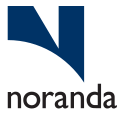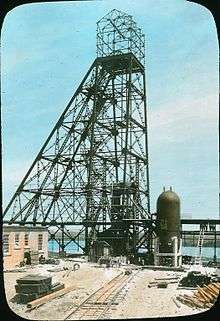Noranda (mining company)
 | |
| Public | |
| Industry | Mining |
| Fate |
Bought Falconbridge Limited; continued as Falconbridge |
| Successor | Falconbridge Limited |
| Founded | 1922 |
| Defunct | 2005 |
| Headquarters | Toronto, Ontario, Canada |
| Products | Copper, gold, zinc, aluminum |

Noranda Inc. was a mining and metallurgy company originally from Rouyn-Noranda, Quebec, Canada. It was listed on the TSX under the symbol NRD.LV. After eventually acquiring a large interest in rival mining company Falconbridge, it merged with that company in 2005. The combined company continued under the name Falconbridge Limited, ending the Noranda name. Only one year later in 2006 Falconbridge was acquired by the Swiss-based mining company Xstrata.
History and operations
Noranda was incorporated in 1922 as Noranda Mines under the leadership of James Y. Murdoch to exploit the Horne deposit, discovered by Edmund Henry Horne (E.H.Horne) on mineral claims he staked in 1920.[1][2] Extraction of copper began on 17 December 1927. Although extraction was originally predicted to last for only three years, additional reserves (the gigantic "Giant H Orebody") were quickly discovered; the mine would form the backbone of Noranda's operations until reserves were exhausted in 1976.
Beginning in 1930, Noranda diversified by acquiring holdings in the forestry, oil, manufacturing, and automotive industries. In 1931, the company opened the CCR refinery in Montréal-Est, which processes all the copper produced by the Horne smelter. Noranda gained its first international property in 1938 with the purchase of the Empresa Minera de Nicaragua gold mine in Nicaragua. The company gained a large interest in Kerr Addison Gold Mines in 1945. In 1955 it opened the Gaspé Copper Mines, and in 1963 Canadian Electrolytic Zinc (CEZ), in which Noranda held a large stake, began production. In 1967, Noranda divested itself at $80 per share of its holdings in Denison Mines, which it had purchased in 1964 for $12 to $18 per share.[3] A sum of $80mn was devoted to Potash mines in Saskatchewan, while $50mn purchased a 51% stake in the Brunswick Mining and Smelting Corporation earlier that year, as well as an investment in Pacific Coast Company, an aluminum products manufacturer based in Cleveland, Ohio.[3]
Following the 1973 Chilean coup d'état, Noranda reclaimed its 49% share in its subsidiary Chile Canadian Mines. The company then invested $600,000 of new capital in its Chilean mines, the first major mining investment after the coup, securing the right to the Andacollo copper reserves in northern Chile in 1976.[4] 1973 also saw the company expand into aluminum with the opening of an aluminum smelter in New Madrid, Missouri, and the oil business with the formation of Canadian Hunter. Asset management companies Brascan and Caisse de Dépôt gained effective control of Noranda with a $1 billion CAD investment in 1981. In 1984 Noranda Mines changed its name to Noranda Inc., as a reflection of its wide diversification. Also in 1984, the company became a large player in the electronics scrap and recycling business by purchasing Micro Metallics Corp. In 1995 Noranda gained full control of Brunswick Mining and Smelting, a zinc mine and smelting company in New Brunswick; they opened a battery recycling facility one year later. Also in 1995 Noranda entered Latin America with the purchase of a 25% stake in the Refimet smelter outside of Antofagasta, Chile. Noranda obtained 100% control in 1998 and ownership of that site aided later expansion into Latin America.
Noranda announced that it would divest itself from all industries unrelated to mining and metals in 1997, and completed the transition the following year, removing itself from the forestry and oil and gas industries. In August 2000, Noranda was the top miner in Canada.[5] The company gained a 34% stake in the huge Antamina copper-zinc mine in Peru, which opened in 2001. In 2002 Noranda opened a large aluminum foil plant in Tennessee, and expanded its recycling business with the opening of an electronic hardware recycling facility in Brampton, Ontario in 2003. Noranda expanded its aluminum business in 2004 by gaining a 50% interest in the Gramercy alumina refinery in Louisiana and associated Jamaican bauxite deposits. By 2005, the company had operations in 18 countries.
Merger
Noranda had bought 19.9% of rival mining company Falconbridge in 1988, which was raised to a 58.4% stake in 2002. In 2005 China Minmetals was rumoured to be interested in buying Noranda, which caused the Canadian federal government to review its foreign investment policy. In June 2005 Noranda completed a merger with Falconbridge, essentially purchasing Falconbridge outright.[6] However, the combined company continued under the name Falconbridge Limited, ending the Noranda name as a large mining company. Brascan reduced its stake in the new company to 20%. Less than a year after completing its merger with Falconbridge, the new company was acquired by Xstrata. The Noranda name continues for companies with Noranda Aluminum, which was the spun off by Xstrata, and the Noranda Income Fund which is a large zinc refinery in Valleyfield, Quebec
See also
- Noranda Caldera
- Edper Investments, which controlled Noranda from 1981 through its ownership of Brascan.
Noranda Mines also operated in the UK in the early 70's with active exploration programs in Scotland and north Wales. The exploration program consisted of soil and stream sampling and limited Induced Polarisation and fluxgate magnetometer surveys.These programs were sufficiently advanced to give rise to drilling programs in Snowdonia(Hafod y llan)either side of the Watkin path, and also in Wester Ross just outside Locharron. Copper mineralisation was encountered in the Welsh drilling program but essentially nothing in Wester Ross. Drilling in Snowdonia was with a hand portable x-ray rig capable of reaching approximately 100ft and in Wester Ross with a Boyles Bros. rotary rig drilling to approximately 1000ft.
References
- ↑ Roberts, Leslie (1956). Noranda. Toronto: Clarke, Irwin & Company. ASIN B0000CPMQI.
- ↑ Pain, S.A. (1960). Three Miles of Gold: The Story of Kirkland Lake. Toronto: The Ryerson Press. p. 21.
- 1 2 The Montreal Gazette - Sep 27, 1967 (see google news)
- ↑ "Canada's Economic Relations with Post Coup Chile", World's Apart May/June 1978, Latin American Working Group, Toronto, pp 63-64.
- ↑ CMJ, Aug 2000, "Noranda Tops 40 Largest Miners"
- ↑ "Noranda to take over Falconbridge". CBC News. March 9, 2005.
External links
- Former website (April 15, 2005 snapshot from the Internet Archive)
- Flash presentation See "About us", "History and Milestones" Retrieved 26 June 2008.